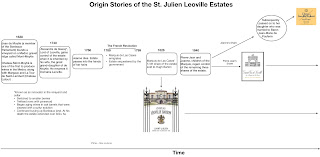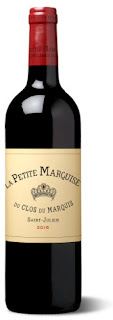The vineyard is divided into seven main blocks and, further, into 125 parcels. Cabernet Sauvignon is planted on the hills while Merlot is planted at the bottom of the slopes.
The vineyard is farmed organically with sustainability the driving force behind vineyard practices:
- Cover crops between rows to prevent soil erosion and boost soil health
- Limits on chemical use. Natural products are used to control pests
- Efficient irrigation systems.
Vineyard management practices include::
- Dense planting scheme — forces vines to compete, resulting in lower yields and higher quality
- Pruning and canopy management by hand; allows for precise control
- Each plot harvested at optimal ripeness
Winemaking at Leoville Las Cases
Philosophy
The Chateau seeks to produce wines:
- Representative of their terroirs
- To be consumed during meals
- With great aging potential
- That improve with age.
Process
The Leoville Las Cases winemaking process is labor-intensive and meticulous and is mostly unchanged from the 19th century. The requirements/steps are as follows:
- Harvesting of high-quality grapes
- These grapes are carefully selected and sorted (including optical sorting (a relatively new innovation)) to ensure that only the best grapes make it into the wine
- Fermentation vessels include wood, concrete, and stainless steel vats of varying sizes. Eight oak vats are reserved for confiscation of the Grand Vin whike cement tanks are used for all other wines.
- Movement of wines within the cellar is via gravity flow
- Malolactic fermentation occurs in tanks
- Blending is conducted post-MLF but prior to oak aging in order to ensure no oak influence in the construction of the blends
- Wines are allowed to mature post fermentation so that they can develop their complex flavors and aromas. Recently the wine has been aged for 18 months in 90% new French oak
- Beginning in 1987, reverse osmosis technology has been employed during the winemaking process to help extract excess water from the mist. This is, of course, controversial among purists.
Wines of Léoville Las Cases
Grand Vin de Léoville
This wine has been described by Berry Bros & Ruud as “… arguably the most exotically perfumed wine in the Medoc and this can be partially attributed to the must being fermented at lower-than-average temperatures, which leads to its youthful, aromatic richness being retained. On the palate it is powerful and concentrated and marvelously well-balanced.”
The wine is structured, firm, austere, and powerful with top vintages taking 15 - 20 years to lose its tannic structure. The wine displays intense ripe fruit flavors of black currant, cassis, and wild blackberries with subtle floral aromas and finely grained tannins. Depending on the vintage, it can present a more upright Pauillac profile or a more tender St Julien profile.
The wine is a blend of Cabernet Sauvignon and Cabernet Franc. Between 9000 and 15,000 cases are produced annually.
Le Petit Lion du Marquis de Las Cases
This is a true second wine made from younger vines. The blend is approximately 45% Cabernet Sauvignon, 45% Merlot, and 10% Cabernet Franc. The wine shows dominant black fruit flavors, graphite, minerality, tobacco, and grainy tannins.
The wine is designed to be more accessible.
Clos du Marquis
This wine was first produced in 1902 with grapes secured from the top terroirs of St Julien that was a part of the Léoville historic vineyard. This wine offers a fine expression of the St Julien character: structure, complexity, harmony, distinction, and aging potential.
Annual production of between 4,000 and 8,000 bottles per year.
La Petite Marquise
Young vines from the Clos du Marquis terroirs. 56% Merlot, 44% Cabernet Sauvignon.








No comments:
Post a Comment